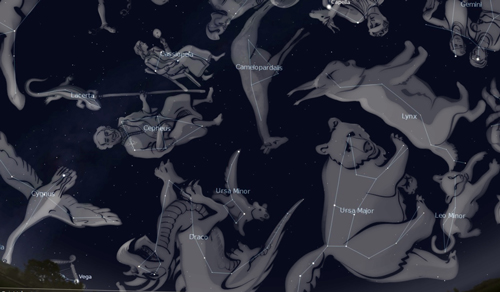This Week’s Sky at a Glance, Jan 28 – Feb 4 ~ by Curt Nason
This might be a good week to pay attention to four lesser known constellations that were created a few centuries ago, by Polish astronomer Johannes Hevelius, to fill in blank areas of the sky. You will need a clear sky with minimal light pollution, and even then you will likely see only a few of the stars in each. Look to the north around 7 pm and use the Big Dipper to locate Polaris, the North Star, halfway up our sky. It is at the end of the handle of the Little Dipper and the two brightest stars of the bowl are below. If you can see the other four stars that complete the handle and bowl then you have a chance of locating these dim constellations.
Above Polaris and to the right of W-shaped Cassiopeia is a giraffe doing a headstand, but if you can see perhaps a large triangle and maybe a few scattered stars then you have spotted Camelopardalis. Hevelius imagined this as a camel with spots like a leopard, hence the odd name. A camel had been imagined here prior to Hevelius. To the left of Polaris is house-shaped Cepheus, with the peak of the roof not far from Polaris. Between Cepheus and the foreleg of Pegasus is a zigzag of faint stars that forms Lacerta the Lizard.
Now look to the right of the Big Dipper and pick out the three pairs of stars that stretch midway up the sky and form the feet of the Great Bear, Ursa Major. This trio of star pairs has been called the Three Leaps of the Gazelle. Between the middle pair and the sickle-shaped mane of Leo the Lion is a squashed triangle forming Leo Minor, the Little Lion. Finally, a long string of faint stars running from Leo Minor and across the front of the Great Bear toward Camelopardalis depicts the elusive constellation of Lynx. Imagination is a wonderful thing.
This Week in the Solar System
Saturday’s sunrise in Moncton is at 7:46 am and sunset will occur at 5:19 pm, giving 9 hours, 33 minutes of daylight (7:49 am and 5:26 pm in Saint John). Next Saturday the Sun will rise at 7:38 am and set at 5:29 pm, giving 9 hours, 51 minutes of daylight (7:41 am and 5:36 pm in Saint John).
The Moon is at first quarter on Friday, February 3, giving great views through a scope from midweek through the weekend. It also provides the opportunity to check an item off your observing list. Late Tuesday morning the Moon passes four degrees (less than three finger-widths at arm’s length) south of Venus. Get them both in binoculars, and then try to see Venus with just your eyes in daylight. It is fairly easy when the sky is clear if you know where to look. The Moon passes by Mars that evening. By midweek Saturn is rising three hours before the Sun and two hours before Mercury. Jupiter rises around 11:30 pm and it is still well placed for viewing in the morning.
The Saint John Astronomy Club meets on February 4 at 7 pm in the Rockwood Park Interpretation Centre. All are welcome.
Questions? You can contact Curt Nason here.

